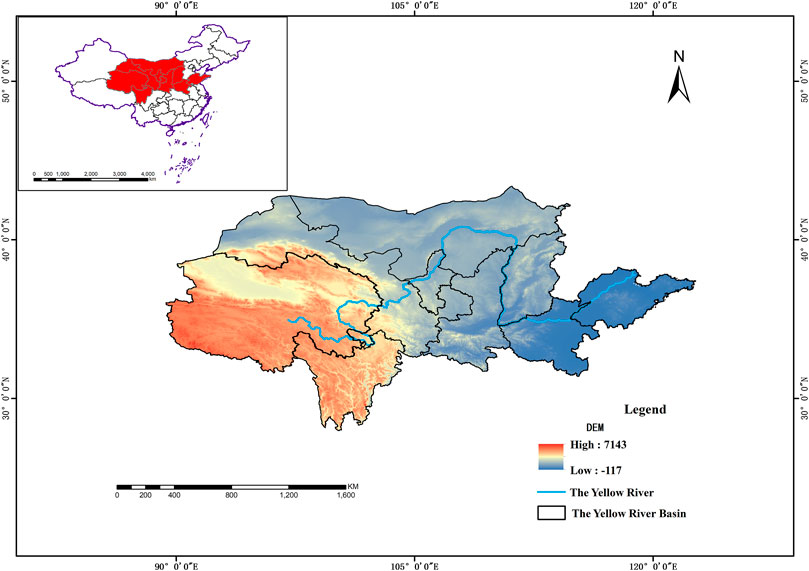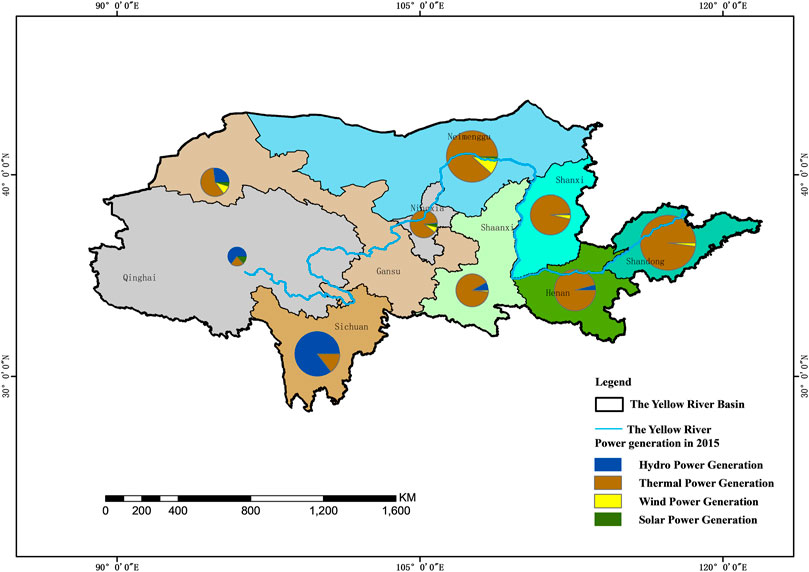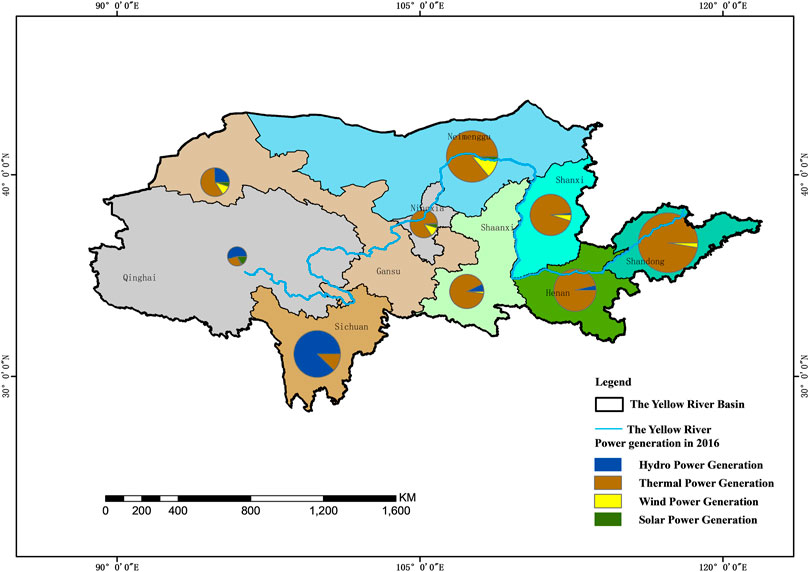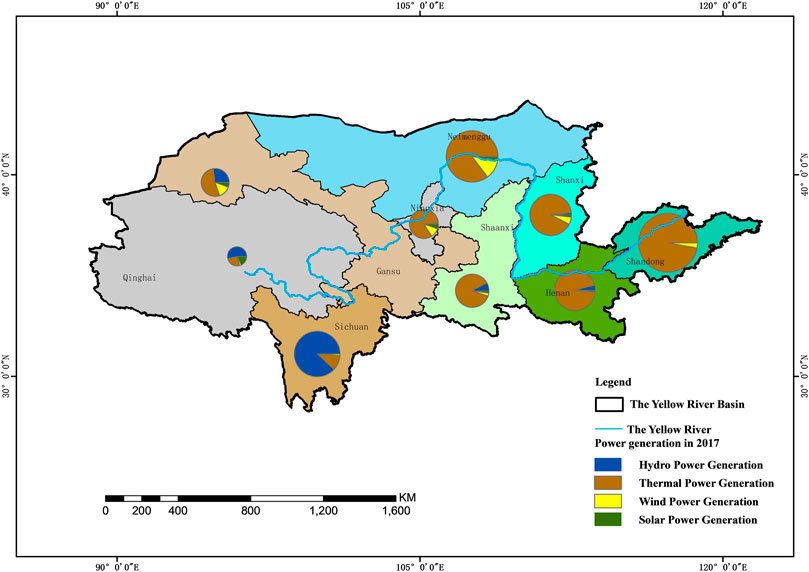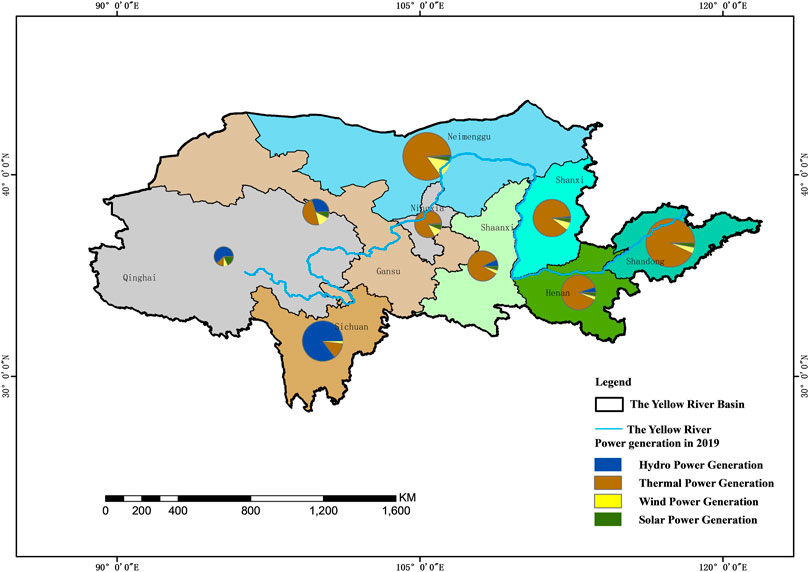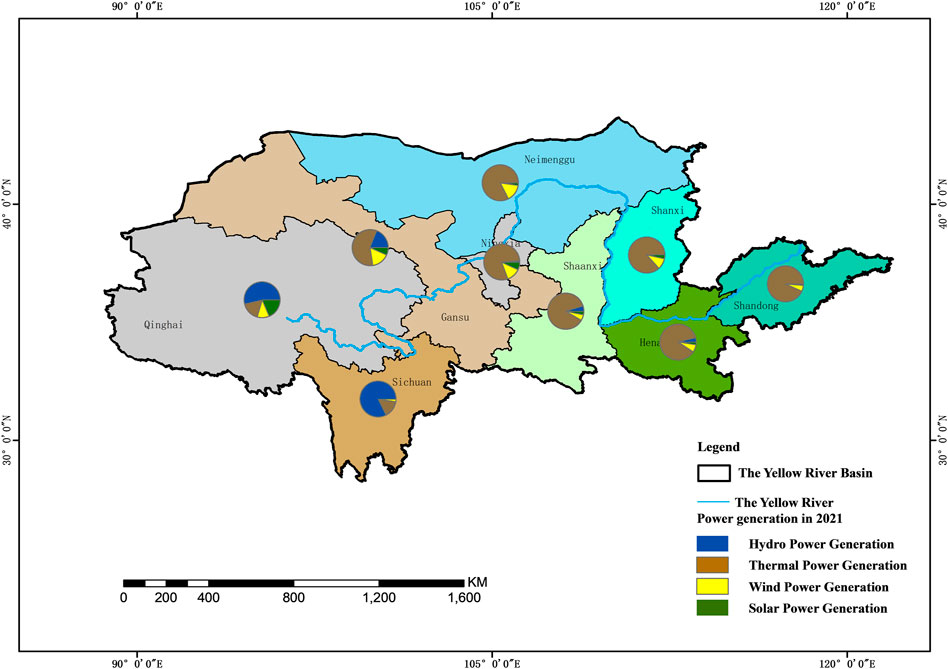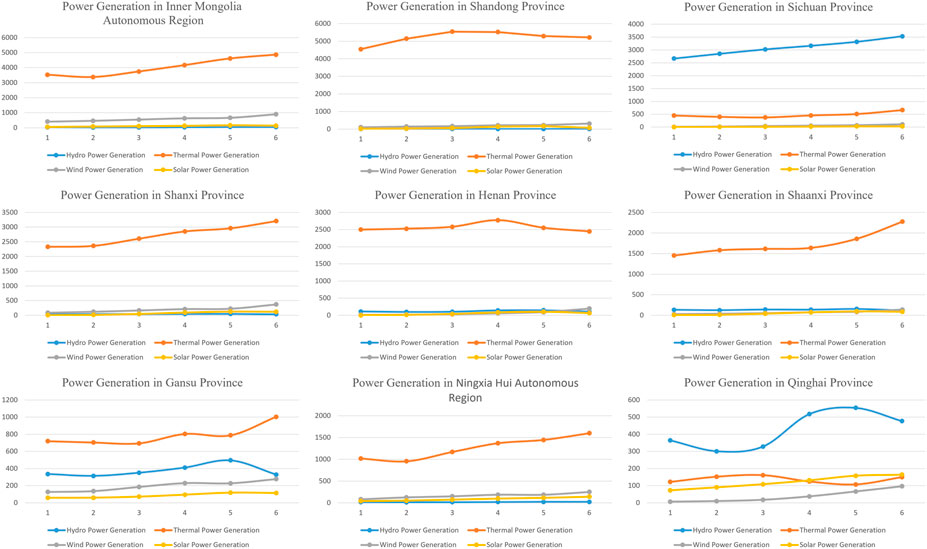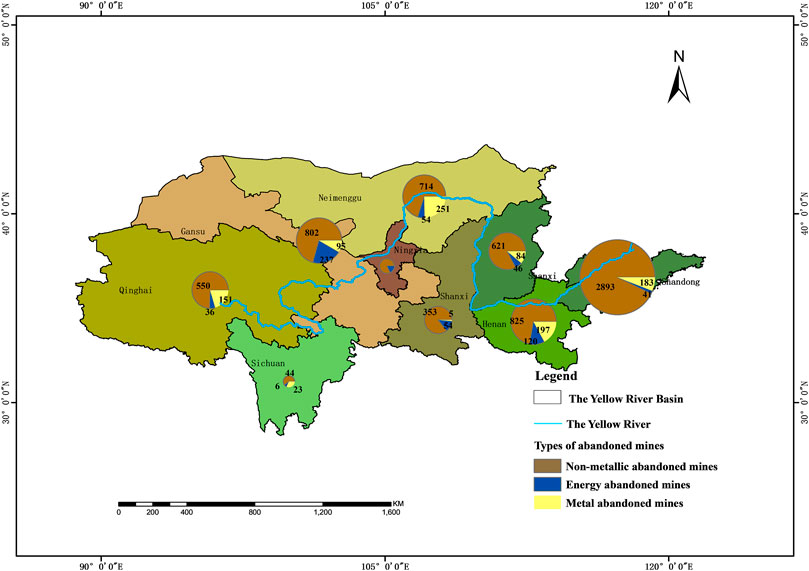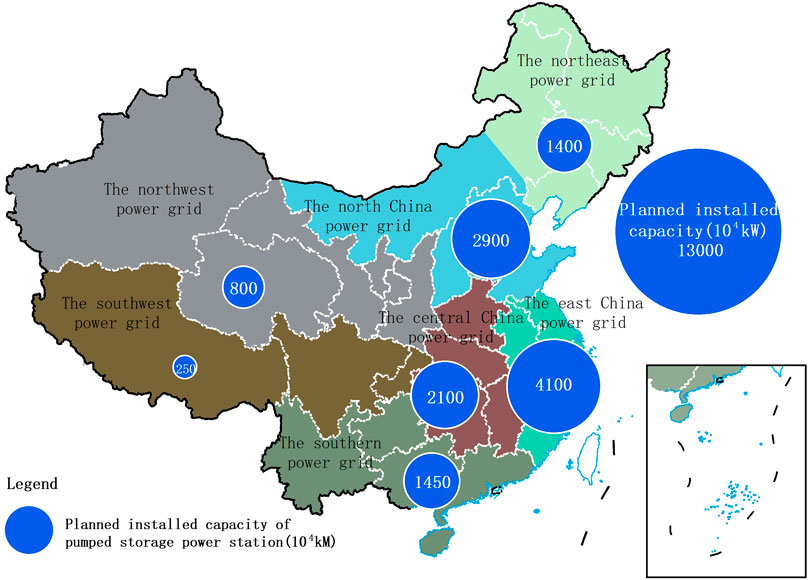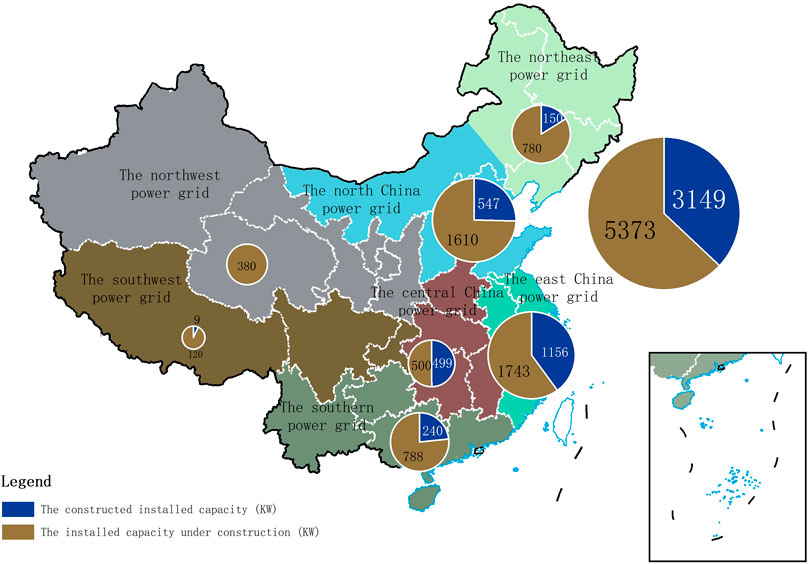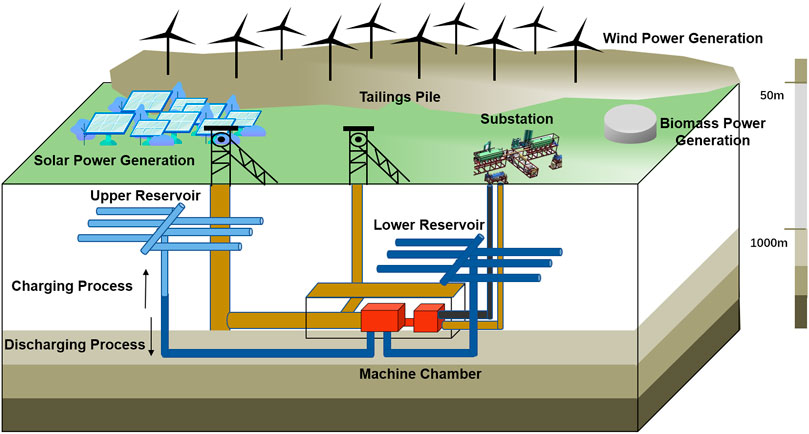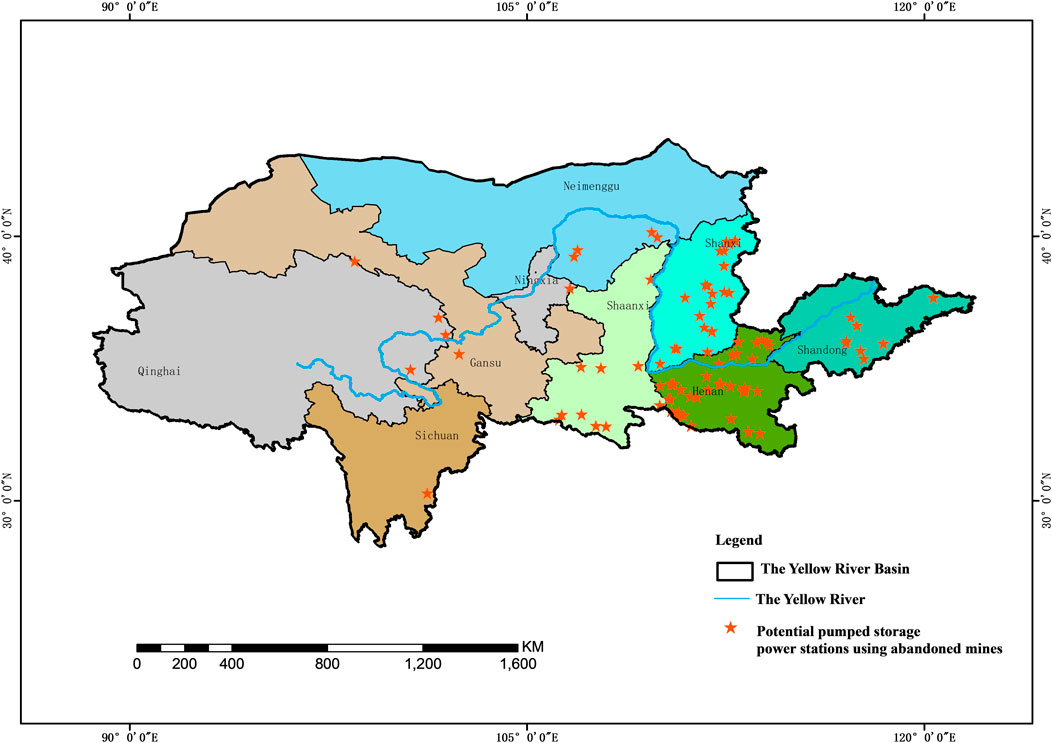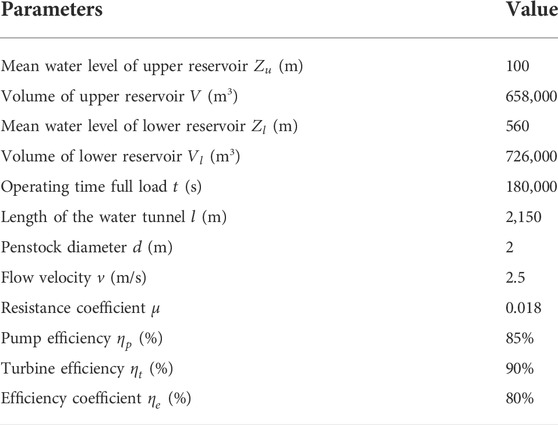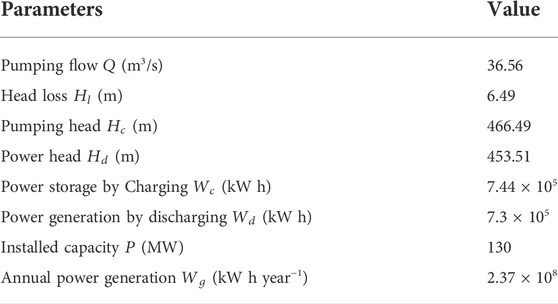- 1Key Laboratory of Mine Ecological Effects and Systematic Restoration, Ministry of Natural Resources, Beijing, China
- 2China Institute of Geo-Environment Monitoring, Beijing, China
- 3College of Geoscience and Surveying Engineering, China University of Mining and Technology (Beijing), Beijing, China
- 4School of Geography and Information Engineering, China University of Geosciences, Wuhan, China
Greenhouse gas emissions, mainly CO2, lead to global climate change, and the resulting ecological environment problems bring severe challenges to human survival and development. As the world’s largest developing country and carbon emitter, China is facing the dual pressure of socio-economic development and carbon emission reduction. In order to cope with global climate change and achieve the goal of carbon neutrality and carbon peak as soon as possible, China needs to accelerate the optimization of energy structure, gradually increase the proportion of renewable energy utilization, and accelerate the solution of the bottleneck problem of renewable energy storage. As an energy basin, the Yellow River basin is a key demonstration area to promote energy system reform in China. There are a large number of abandoned mines in the Yellow River basin, which provide a new idea to build pumped storage power stations using abandoned mines (PSPSuM) for renewable energy storage. From the perspective of multidisciplinary integration, this study deeply discusses the relevant evaluation principles and technical key points of constructing PSPSuM in the region, and preliminarily carries out the feasibility assessment. The results show that 91 PSPSuM can be built in the Yellow River basin, with a total installed capacity of 15,830 MW, comprehensively considering the aspects of spatial size, spatial structure and space stability.
1 Introduction
Since the Industrial Revolution, the utilization of fossil energy such as coal, oil and natural gas has given rise to the dramatic increase in labor productivity and in the development of human society. However, the fossil energy also has brought about carbon emission, which is on continuous growth and has become the main cause of global climate warming. For more than 200 years, CO2 concentrations has been on the rise, from around 280 ppm before the industrial revolution to 419 ppm in 2021 (NOAA, 2021). The cumulative amount of carbon dioxide (CO2) from fossil fuel burning has reached 2.2 trillion tons. The global average surface temperature has increased by about 1.1°C, making 2011–2020 the warmest decade on record. In 2018, the United Nations Intergovernmental Panel on Climate Change (IPCC) released the Special Report on Global Warming 1.5°C (IPCC, 2018), which pointed out that global temperature has been observed to get higher, and the impact on human beings, when the temperature rise reached 2°C, is much more serious than the early prediction. The working Group I report of the Sixth Assessment Report of the Intergovernmental Panel on Climate Change (IPCC) released in 2021 shows that human activities have caused unprecedented changes in the climate system (IPCC, 2021). The past 50 years since 1970 have been the warmest in the last two thousand years, and global warming, as predicted, will continue to stick around until the middle of the century.
Global warming, caused by CO2 emission of greenhouse gases, is considered as a non-traditional security issue worldwidely. Greenhouse effect has triggered serious ecological environment problems, affecting almost every corner on Earth. Those problems, including temperature rising, sea level increase, and frequent extreme weather, have brought severe challenges to human survival and development, particularly on global food supply, water, ecosystem, energy, infrastructure and human life (CSG, 2021; Huang et al., 2021). As the world’s second largest economy, China’s annual CO2 emissions have listed the top of the world. In terms of total energy consumption, in 2020, China consumed 4.98 billion tons of standard coal, ranking first in the world, accounting for 30.9% of the global total consumption, and more than the United States (13.9%), India (7.2%) and Russia (4.5%) combined (Su et al., 2021). Energy-related carbon dioxide emissions are about 9.9 billion tons, accounting for 1/3 of the global sum (BP, 2021), and carbon emissions per unit GDP are 6.7 tons of carbon dioxide/$10,000, both are far higher than the world average. From the perspective of energy consumption structure, fossil fuels such as coal, oil and natural gas are the main sources, accounting for more than 84% in 2020 (BP, 2021). In particular, coal consumption accounts for more than half, much higher than the average proportion in the global energy consumption structure.
China’s rapid economic growth is accompanied by an increasing demand of energy, and carbon emissions are still rising and have not yet peaked. Facing with strong international pressure to reduce carbon emissions, as the world’s largest developing country and carbon emitter, Chinese government pledged at the Copenhagen Climate Change Conference to reduce carbon emissions per unit of GDP by 40%–45% by 2020, compared with 2005. In 2016, Chinese government formally signed Paris Agreement, solemnly committing to carbon peak by 2030. In September 2020, at the 75th Session of the United Nations General Assembly, China made an earnest commitment to the world that it would strive to achieve the goal of peaking carbon dioxide emissions by 2030 and achieve carbon neutrality by 2060 (Liu et al., 2019; Xi, 2020; Zhang and Xi, 2020; Huang and Xie., 2021). To deliver these promises, Chinese government is balancing socio-economic development and carbon emissions, which is not only a major decision in China, but also a heated discussed topic concerning the whole society.
Energy is one of the important material basis of economic and social development, as well as the main source of carbon emissions. To ensure a smooth realization of carbon neutral in China as promised, China’s green low carbon development on energy structure is gearing up for the new challenge. The situation is not favorable, the energy consumption is going up, resource constraints are tightened, and the environmental pressure is aggravated. Under these circumstances, reducing the consumption of traditional fossil fuels while increasing the development and utilization of clean and renewable energy is an imposition. According to preliminary calculation, in 2020, the proportion of renewable energy in China’s total energy consumption will increase to 15.9%, a significant increase of 8.5% compared with 2005. The total installed capacity of renewable energy power generation will reach 980 million kW, accounting for 44.7% of the total installed capacity. The utilization of renewable energy is an important measure for China, to solve current resource and environmental problems, mitigate and adapt to climate change, and realize the sustainable development of the resource-environment coupling system. China gives priority to renewable energy development, and vigorously develops and utilizes renewable energy. In 2020, green and low-carbon energy from wind power, photovoltaic, hydropower, biomass power and nuclear power reached 280 million kW, 250 million kW, 370 million kW, 29.52 million kW, and 49.89 million kW respectively, reaching 2.6 trillion kWh of electricity generated from non-fossil energy sources, accounting for more than one third of China’s electricity consumption (CPEM, 2021). The installed capacity of photovoltaic and wind power increased by more than 3,000 times and 200 times, compared to the year of 2005.
China is rich in renewable energy, but the actual utilization efficiency is relatively low. The main reason is the renewable energy, particularly wind and solar energy, is restricted by the natural geographical conditions, making it intermittent, volatile and unstable. In the actual process of exploitation and utilization, a large amount of wind and solar power are abandoned. In order to use renewable energy efficiently, stably and safely, as well as to achieve the strategic goal by 2030, more than 1.2 billion kW wind and solar power should be generated (CPEM, 2021), corresponding energy storage facilities are needed. Energy storage is the core technology to achieve the large-scale development of renewable energy, the construction of a new power system and achieve the carbon neutrality goal. As electrical energy carrier, energy storage can effectively slow a large-scale new energy power grid volatility and intermittent, promote the balance of power system in the operation of the power and load, improve the safety, economy and flexibility of power grid operation. As carbon neutral has become a global consensus, the proportion of new energy in the whole energy system will increase rapidly, and energy storage technology is also ushering in explosive growth.
Pumped storage technology is currently the most mature, economical and the one that employs large-scale development conditions among all the green low carbon flexible adjustment technology in power system. Pumped storage power station (PSPS) is a clean and efficient renewable energy storage facilities, which can build new renewable energy power system combined with wind, solar power, nuclear power and thermal power. However, the terrain divide, the large amount of land space occupation and other constraints seriously restrict the build-ability of PSPS. After mining, a large amount of usable space is left on the surface and underground, and a PSPS with gravitational potential energy difference can be built by using multiple open pit with height difference, combination of open pit and underground space or pure underground space. In this case, using a large amount of above-ground and underground space of abandoned mines will eliminate the constraints of the site selection of PSPS and greatly increase their build-ability in plains and areas with limited surface space.
In the areas rich in new energy, using the ground and underground space of abandoned mines to build PSPS can, on the one hand, greatly save the surface construction land, avoid the waste of a large amount of underground space, and realize the deep ecological restoration of abandoned mines (Xi et al., 2020). On the other hand, it can effectively alleviate China’s renewable energy storage crisis, promote the transformation and upgrading of energy structure, and greatly reduce carbon emission intensity. It is of great strategic significance for China to achieve the goal of carbon peak and carbon neutrality as soon as possible, and is a new form of PSPS development and construction worthy of in-depth study and promotion.
China’s Yellow River basin is called energy basin with abundant resources including coal (Xi, 2019), oil, natural gas and non-ferrous metal. Its coal reserves are large and complete in types, and its coal production accounts for about 70% of the total national output, making it China’s significant energy, chemical, raw materials and basic industry base (Jin, 2019; Gao et al., 2002). Therefore, the Yellow River basin is a key area for China to promote transformation and upgrading energy system, build an efficient modern energy system with clean and low carbon emissions, and to achieve the strategic goal of carbon neutrality and carbon peak. The Yellow River basin has a huge number of abandoned mines, which leaves a large amount of ground and underground space that can be reused (Zhang and Xi, 2020). At the same time, the Yellow River basin is rich in wind and solar energy, and the abandoned mines have a high spatial correlation with renewable energy areas. How to make full use of these abandoned Spaces to build PSPS and realize efficient and flexible storage of renewable energy is a scientific and technical problem that needs to be solved urgently.
2 Study area
2.1 Overview of the Yellow River basin
The Yellow River is the second longest river in China. It originates in the Yuogu Zonglie basin at the northern foot of Bayan Kala Mountain in Qinghai Province. The main body of the Yellow River, with a total length of 5,464 km, flows through nine provinces and regions in Qinghai, Sichuan, Gansu, Ningxia, Inner Mongolia, Shaanxi, Shanxi, Henan, and Shandong, and finally empty into the Bohai Sea. The Yellow River is seen as the mother river of China, and the Yellow River basin is an important birthplace of Chinese civilization, as well as an important ecological barrier and economic zone in China. Located between 95°59’—118°58′ E and 31°56’—42°03′ N (Figure 1), the Yellow River basin covers 27% of China’s total land area. In 2018, provinces along the Yellow River had a total population of 420 million, accounting for 30.3% of China’s population. Their regional GNP exceeded 23.9 trillion yuan, accounting for 26.5% of China’s GDP in 2018 (Xi et al., 2022).
2.2 Energy structure
The Yellow River basin is rich in coal, oil, natural gas, non-ferrous metals and other mineral resources. The reserves of coal and natural gas account for 75% and 61% of the national basic reserves respectively. Among the 14 coal bases in China, nine coal bases including shendong, Northern Shaanxi, Eastern Ningxia, Western Shandong, Huanglong, Henan, Northern Shanxi, Jinzhong and Eastern Shanxi are located in the Yellow River basin (NEA, 2021).
Figures 2–8 show the energy Structure of provinces in the Yellow River basin from 2015 to 2021 (Peng and Bi., 2020). On the whole, except Sichuan province and Qinghai province in the upper Reaches of the Yellow River, where hydropower is the main power system, the other seven provinces rich in energy and mineral resources are mainly based on thermal power generation, and the proportion of renewable energy generation is relatively low. With the rapid socio-economic development in the Yellow River basin, the demand for energy in all provinces is increasing year by year. Thermal power generation and renewable energy generation in most provinces show a slow growth trend. Only the thermal power generation in Shandong province and Henan province shows an inverted U-shaped trend. In the solar energy enrichment area, the overall development and utilization degree of renewable energy is not high, and the proportion of renewable energy generation is relatively low.
For many years, the Yellow River basin, as China’s main energy industry gathering area, formed a low-end industrial structure dominated by mining, energy and chemical industry (Zhang and Xi, 2020). The large-scale development and utilization of mineral resources indeed strongly support the rapid development of industrialization and urbanization in the Yellow River basin, but they also bring great pressure to the regional ecological environment. The Yellow River basin has gradually become one of the regions with the most concentrated carbon emissions in China. Under the guidance of carbon neutrality goal, the industrial structure adjustment in the Yellow River basin will be around the transformation of low carbon on its supply chain and the upgrading its low-end industry structure. It means vigorously promoting regional renewable energy development and utilization, and increasing the renewable energy’s proportion in primary energy consumption structure. The middle and upper reaches of the Yellow River basin, with abundant wind and solar energy resources, provides basic guarantee conditions for the implementation of these measures (Zhang H et al., 2022). However, it should also be noted that the phenomenon of abandoning wind and solar energy is common in the area, and the development and construction of new energy storage system urgently need to be strengthened. The construction of PSPS by utilizing the space of a large number of abandoned mines in the Yellow River basin provides an action path worthy of in-depth study and discussion.
2.3 Distribution of abandoned mines
According to the research from China Geological Survey, there are 8,429 mines in the Yellow River basin according to the types of mineral resources. The number of non-metallic mines in the Yellow River basin is 6,803, accounting for 80.71%. The second is Metal mines, 989 in total, accounting for 11.73%; energy mines are the least, with a total of 630, accounting for 7.47%. According to the mine scale, small mines in the area have the most, with a total of 8,178, accounting for 97.02%. Secondly, there are 170 medium-sized mines, accounting for 2.02%; There are 81 large mines in total, accounting for 0.96%. The spatial distribution of abandoned mines in each province is shown in Figure 9.
According to the preliminary estimate of China Geological Survey, taking into account the proportional relationship between the mining scale and the usable underground space, based on an average underground space resource of 600,000 m3 per mine, and effective utilization coefficient of underground space more than 60%, it is estimated that abandoned mines in the Yellow River basin can provide about 300,000 m3 underground space, providing a broad space conditions for the construction of PSPS.
3 Introduction of PSPS
3.1 Development history of PSPS
PSPS uses the gravitational potential energy of water as an energy medium to complete energy conversion and storage. When there is energy storage demand, electric energy is used to pump the water from the lower reservoir to the upper reservoir, and the electric energy is converted into the gravitational potential energy of water and stored. When there is a request for energy utilization, the water is released from the upper reservoir to lower reservoir, and the generator is driven by turbine to generate electricity, in this way the gravitational potential energy of water is converted into electricity.
The application history of PSPS can be traced back to more than 100 years ago. In 1901, the world’s first PSPS prototype patent was submitted in the United States, and was approved by the United States Patent Office in 1917. The patent content is to convert the wind energy generated by the windmill on the ground into potential energy of water, through the underground water pump, turbines, generators and other devices which can be used to store wind energy in times of energy crisis (U.S. Patent, 1917).
Although pumped storage technology was invented earlier, it was not until the 1970s, along with the large-scale development and utilization of nuclear energy in Europe, that PSPS were really widely promoted and applied, mainly used to balance the fluctuation of daily power supply caused by unstable nuclear energy (Boust, 2012). Compared with other energy storage facilities, the PSPS has a higher energy conversion efficiency (up to about 80%). At the same time, the storage capacity can be flexibly adjusted by the area of the storage area and water head. Due to the large capacity, long life and efficient characteristics, PSPS has become the ideal storage facilities for energy storage. Huge applications demand has greatly promoted the development of the pumped storage industry. Since the 1970s, many scientific research institutions of Europe embarked on pumped storage related scientific research, published many representative works during this period (ANL, 1976; EPRI, 1976; NASA, 1976; Walia and McCreath, 1976; HEC, 1977; Chas, 1978; Tam et al., 1979; Chang and Thompson, 1980; Chang and Thompson, 1980; Xie et al., 2015; Yuan, 2017; Luo et al., 2018).
With the continuous application of pumped storage technology development, the requirements of terrain and the interference effect on the ground landscape gradually unfolded. PSPS requires a larger water head to complete the conversion of water potential energy, which can only be adopted in the region with great relief (hilly mountain area, for example). Plain regions, such as the gentle terrain, limits the application of pumped storage technology. At the same time, surface water storage facilities will have a certain degree of aesthetic impact on the ecological landscape. With the enhancement of people’s awareness of ecological protection, the environmental impact of the above-ground PSPS also limits its large-scale application. Based on this, the researchers in European countries and America gradually shifted their study from above-ground to underground, and embarked on the feasibility study of underground PSPS, including underground construction requirements of PSPS, the location criteria and evaluation of construction cost, etc., The more representative research results are from the Argonne national laboratory (ANL, 1976). The report systemic evaluated the potential of building underground PSPS in the United States. It discusses the principle for the site selection of PSPS, and points out the strength of surrounding rock for the construction of water reservoir plays an important role. Also, it further argues that intrusive rocks and metamorphic rocks with low permeability are more suitable for the construction of underground PSPS than sedimentary rocks. At the same time, the report also evaluates the construction cost, pointing out that the construction of above-ground reservoir and auxiliary cavern has little impact on the total construction cost of underground PSPS, and the construction cost mainly comes from the construction of underground water reservoir.
3.2 Overview of the development of PSPS in China
According to the PSPS construction plan of the National Energy Administration of China (HPDGI, 2022), by 2020, China’s total planned installed capacity of PSPS (including existing sites) will be about 13,000 kW, as shown in Figure 10. Among them, East China Power Grid has the largest total installed capacity, about 41 million kW, followed by North China Power Grid and Central China Power Grid, and Southwest Power Grid has the smallest total installed capacity, about 2.5 million kW. Compared with other countries in the world, China’s overall development speed of PSPS is relatively fast, and the PSPS under construction ranks first in the world. The total installed capacity of PSPS in China is 31.49 million kW. The installed capacity of North China, East China, Central China, Northeast China, South China and Southwest power grid regions is 5.47 million kW, 11.56 million kW, 4.99 million kW, 1.5 million kW, 7.88 million kW and 90 million kW, respectively. The installed capacity of PSPS in East China Power Grid is the largest, followed by that in South China power grid and North China Power grid, as shown in Figure 11.
PSPS has the capacity to track system load fast, to carry out smooth and rapid adjustment of active power and reactive power, and to bear the important role of reactive dynamic support. The coordinated operation of PSPS and new energy generation can significantly improve the comprehensive utilization rate of renewable energy. However, from the perspective of renewable energy endowment and utilization efficiency, it is still necessary to accelerate the development of PSPS in a scientific and orderly way in the Yellow River basin.
4 Feasibility analysis of pumped storage power station using abandoned mine (PSPSuM) in the Yellow River basin
4.1 Concept of PSPSuM
PSPS require a relatively large water head to complete the conversion of hydraulic potential energy, but the relatively flat terrain in a large number of plain areas limits the large-scale application. Therefore, the construction of underground PSPS has become an inevitable choice to solve the bottleneck problem of renewable energy storage. Abandoned mines have large underground space and water head, And the underground space with relatively stable mechanical properties of surrounding rock can provide safe and reliable space guarantee for upper and lower reservoirs and machine caverns.
At the same time, the shaft makes the traffic convenient and the large amount of mine water after purification treatment can be enough water resource for upper and lower reservoir. Making full use of the underground space with stable structures in the abandoned mines to build underground PSPS, on the one hand, can effectively save the construction cost of underground water reservoir; On the other hand, it can avoid the influence of the construction of above-ground water storage engineering facilities on the surface landscape and reduce the ecological disturbance effect (Xi et al., 2020). The concept of PSPSuM is shown in Figure 12.
Back in the 1980s, TU delft in Netherlands had conducted a feasibility study on the use of abandoned coal mine to construct PSPS. Although the final results show that at the time, due to the limited technical and economic conditions, the use of abandoned coal mine to underground PSPS is not viable (Busch and Kaiser, 2013), the research pointed out the subsequent research direction, and extended the research boundary. In 1993, the United States built mount Hope Semi-underground PSPS in New Jersey by using open pit iron mine. In 2009, funded by the German Federal Ministry of Environmental Protection and Nuclear Energy Safety (BMU), the German Energy Research Center of Lower Saxony (EFZN) carried out the construction of underground PSPSuM (Schmidt et al., 2011; Busch and Kaiser, 2013; BMWI 2014). It determined that six mining areas in Germany, including Erzgebirge, Harz and Siegerland, were suitable or partially suitable for the construction of underground PSPSuM. According to preliminary estimates, up to 10 GW of installed capacity could be built in these mining areas under ideal conditions. In 2018, RAG group, together with other local scientific research institutes, carried out the feasibility study of abandoned coal mine PSPS in Prosper-Haniel mining area, which has built the world’s first abandoned coal mine PSPS model with a installed capacity of 200 MW (UDE, 2014).
4.2 Technical essential
In general, a series of studies from suitability analysis to engineering design have been carried out on PSPSuM in the world, and the possibility and technical key points of constructing PSPSuM for renewable energy storage have been discussed. The studies show that using abandoned mines to build PSPS can be an effective means of renewable energy storage under the strategic condition of new energy transformation, and it is also operable in construction and implementation in terms of technical conditions risk assessment, environmental planning and economic benefits, and project approval. However, the planning and construction of an PSPSuM is a complex multi-disciplinary challenge, which requires an overall consideration of various disciplines including rock mechanics, mining, mining surveying, machinery manufacturing, power system, economics, ecology and law, and the coordination of scientific research forces of various professional disciplines to carry out comprehensive evaluation.
4.2.1 Rock mechanics
The stability of the surrounding rock of abandoned mine is the precondition to the construction of PSPSuM, including water reservoirs, machine cavern and mechanical stability of transportation roadway. The basic indicators for evaluating the stability of surrounding rock include formation lithology, rock mechanics, Initial stress state of underground space, Rock stress-strain, hydraulic characteristics, Water-rock coupling effect, Mining depth, exploitation method and so on.
In general, compared with sedimentary rock, intrusive rock and metamorphic rock with low permeability, are more suitable for building underground PSPS. When the design of the PSPS begins, the first step should be the analysis and research on the stability of surrounding rock. The mechanical properties of surrounding rock under the coupling effects of water and rock should be analyzed to reveal the boundary conditions of surrounding rock instability. Then, based on the analysis results, a scheme for planning of underground water reservoir, and for the stability of surrounding rock in areas with weak supporting structure should be mapped out.
4.2.2 Mine planning
According to the mining conditions and the structure of underground space, the capacity of underground space, mining depth and its topological relationship with ore deposit type should be analyzed. The limitation indexes such as shaft access and mine closure time should be estimated, and the suitability of underground PSPSuM is preliminarily evaluated.
1) Type of deposit: According to the strike of the deposit, it can be roughly divided into inclined and horizontal ones, and according to the distribution of the deposit, it can be roughly categorized into lenticular or massive. Generally speaking, for the construction of underground PSPSuM, the type of horizontal massive deposit is the ideal condition to achieve large capacity storage.
2) Mining depth: mining depth determines the hydraulic head of the PSPS, which indirectly determines the energy storage capacity. Generally speaking, hydraulic head can also be realized through the combination of multiple shafts and tunnel systems.
3) Underground space capacity and its topological relationship: besides mining depth, underground space capacity is another important index that determines the storage capacity of PSPSuM. The topological relationship of underground space determines the planning and configuration of underground space, including storage space machine chamber and other auxiliary chambers.
4) Supporting conditions: the supporting conditions of abandoned mine are important factors to improve the stability of surrounding rock. Under normal circumstances, the support measures of underground auxiliary chamber are relatively complete and the stability of surrounding rock is good, while the support measures of goaf are relatively weak and the stability of surrounding rock is poor. Compared with the abandoned mine with longer closure time, the abandoned mine with shorter closure time has better supporting condition.
5) Transportability of shaft: Large machinery and equipment of PSPSuM need to be transported to underground mechanical chamber through shaft. For power station with large energy storage capacity, the diameter of shaft is an important factor restricting the transportability of machine.
6) Mine closure time: mine closure time can not only be used as an indicator to judge the integrity of support measures, but also determine the reuse degree. Generally speaking, the mine that is about to be closed has not implemented the closure procedure, so the transportation channel can be opened without additional cost. Moreover, there is also real-time information about mine water changing state in those mines, which is convenient for the construction planning of PSPS.
Through the analysis of the related parameters of abandoned mine, 3d visualization models of abandoned mine space can be mapped out using geographic information system and mining aided design software. Then combined with the mechanical characteristics of surrounding rock, the well-rounded design concerning the upper and lower water reservoirs, Penstock, machine cavern, auxiliary traffic and underground transmission line can be arranged.
4.2.3 Machine arrangement
It mainly includes the selection of hydraulic machinery components according to the evaluation indexes such as the hydraulic head of the PSPS, the storage capacity of the abandoned mine shaft, and the space volume of the mechanical chamber. At the same time, the rational configuration of the machines (pump, turbine, generator), debugging of mechanical performance and carrying out mechanical operation scenario simulation should also be considered.
4.2.4 Energy system design
Based on the design principle of energy management system, the framework conditions of renewable energy grid connection should be analysed. Combined with the constraints of power balance, the operation constraints of PSPS and renewable energy consumption, The power conversion efficiency under different scenarios should be calculated by professional power system simulation software to simulate public power grid. At the same time, economic benefit evaluation under different coupling scenarios should also be carried out, and the bottleneck data of public power grid will be analysed in cooperation with researchers from other disciplines, with the goal to minimize the total operation cost of the combined power generation system and improve the power generation efficiency.
4.2.5 Compliance
The researches on relevant laws and regulations of existing abandoned mines and PSPS, should be carried out. Based on relevant engineering fields involved in the construction, operation and maintenance of underground PSPSuM, the potential legal constraints should be analyzed according to the current laws and regulations in various fields, and the legal compliance of PSPSuM should be determined.
4.2.6 Environmental implication
The construction and operation process of underground PSPS will inevitably affect the local ecological environment. Therefore, at the beginning of planning, detailed environmental impact assessment should be carried out according to the actual situation of abandoned mines and planned engineering activities, focusing on the analysis of engineering activities’ impact on water resources, biodiversity and landscape. The potential influence of water environment and water ecology, and the activation effect of water-rock interaction on harmful substances in mine should be evaluated. Renewable energy development (especially photovoltaic power plants) and PSPS construction also have potential impacts on habitats and animal migration paths, which should be subject to thematic assessment at the time of planning. In addition, the potential impact of the layout of surface transmission lines and the construction of substation facilities on the landscape should also be taken into account, especially when the power station is built around the city area.
4.2.7 Economical efficiency
Relevant studies in Germany have found that under the premise of ensuring the operation safety, compared with traditional energy storage forms, economical efficiency is the key factor restricting the feasibility of PSPSuM (Schmidt et al., 2011). The main factors influencing the construction cost should be detected before the construction process of PSPSuM. The simulation studies, which focus on the cost-benefit under the conditions of different energy storage capacity of PSPSuM, provides cost optimalization potential. Together with researchers from related science domains, a solution to reduce the construction cost of PSPSuM can be proposed, after a sophisticated analysis on underground water reservoir, mechanical configuration, power system planning, energy market and other factors.
4.3 Potential estimation
The Yellow River basin has a vast land area and excellent resource and environmental endowment. Solar energy and wind energy resources are abundant and widely distributed in the Yellow River basin. At the same time, the huge above-ground and underground space left by numerous and widely distributed abandoned mines in the Yellow River basin has laid a good foundation for the storage of renewable energy. Especially in Qinghai, Gansu, Inner Mongolia in the Northwest of the Yellow River basin, there is a high spatial correlation between the renewable energy enrichment areas, mainly wind and solar energy, and the mining areas. The preliminary analysis and research on the potential of PSPSuM should be carried out under with full reference to the international pilot study examples, which aims to unify the interdisciplinary theories concerning rock mechanics, mining, mining surveying, machinery manufacturing, power system, economics, ecology and law.
Based on the national mine geological environment survey database from China Geological Survey (Li and Zhang, 2018), the preliminary potential analysis of PSPSuM in the Yellow River basin is mainly based on four indicators: the availability of underground space, the spatial structure, the geo-environmental conditions and the installed capacity. Firstly, the available underground space and its spatial structure of abandoned mine were estimated, according to the basic information such as the actual production capacity, the amount of ore produced, the area of mined-out area, the maximum mining depth, the maximum mining thickness and the mining method. Secondly, according to the requirements of the PSPSuM for the stability of surrounding rock, the abandoned mine whose geological environment conditions meet the safety requirements of engineering construction and operation is selected. Finally, 100 MW is taken as the minimum installed capacity. Taking into account selection indicators such as space size, space structure and stability, 91 abandoned mines suitable for the construction of PSPSuM were selected in the Yellow River basin, with a total estimated installed capacity of 15,830 MW. Their spatial distribution is shown in Figure 13.
4.4 Case study
The charging and power generating process is simulated in an abandoned mine selected from the Yellow River basin for the construction of a PSPSuM. The specific parameters of the PSPSuM are shown in Table1.
4.4.1 Charging process
In the charging process, the electric power generated by renewable energy is used to pump water from the lower reservoir to the upper reservoir. In this way, the electric power is converted into the gravity potential energy of water. The pumping flow Q is calculated by the following Formula:
In this process, the frictional resistance along the flowing path and the sharp change of local boundary will lead to head loss, which is calculated by the following formulas:
The actual average pumping head is determined by the average water level of upper and lower reservoirs and the head loss, as follows:
The maximum power consumption of the pumping process, that is, the power generated by renewable energy consumed by charging, is calculated by the following formula:
4.4.2 Discharging process
In the process of power generation, water flows from the upper reservoir through the penstock, drives the generator and finally flows to the lower reservoir to convert the gravitational potential energy of water into electrical power. The average head of power generation is calculated as follows:
The maximum generated electric power is calculated by the following formula:
Thus, it can be concluded that the installed capacity of PSPSuM is:
The power conversion of the charging and discharging process are shown in Table 2.
5 Discussion
According to the preliminary evaluation results of PSPSuM in the Yellow River basin, With 100 MW as the minimum installed capacity, at least 91 PSPSuM can be built by utilizing existing abandoned mines under the consideration of underground space, spatial structure and surrounding rock stability. The total installed capacity reaches 15830 MW. Based on an average full load time of 5 h, a single charging can store 7.92 × 107 kWh of renewable energy. 1 kWh is equivalent to 0.123 kg standard coal heat conversion, so a single discharging can be converted into 0.97 × 104 tons of standard coal. According to the average annual charging and discharging cycle times of 400, 0.39 million tons of standard coal could be saved annually, reducing carbon dioxide emissions of about one million tons. The effect is very prominent.
Wind and solar power resources in China is mainly concentrated along the provinces of Qinghai, Inner Mongolia and Gansu of the Yellow River basin. In those regions, the landscape are mainly plains with wind-blown sands, gobi, deserts and other unused lands. In the future, these areas can make full use of excellent renewable energy endowment to speed up the construction of large wind and solar power base (Zhang Y et al., 2022). At the same time, they are one of the most enrichment areas of China’s coal resources. Therefore, In the future, a variety of energy forms and complementary energy technologies can be integrated and utilized in the region. The abandoned mines with large above-ground and underground space in these regions should be used to construct PSPSuM, adjusting to local conditions. The factors, such as regional electricity supply, the waste of wind power, energy storage capacity and the mutability of electricity, should be fully considered to utilize renewable energy in the Yellow River basin, relying on the established inter-provincial transmission channels and thermal power point-to-point network transmission channels.
The natural environment and socio-economic development levels are highly different between China and developed countries in Europe and the United States. Those differences predetermined the diverse features of the abandoned mines and the methods in reusing them. Compared to those countries mentioned above, abandoned mines in China are unique in their complex mine geological environment, problems left over by governance in the past, and insufficient restoration and serious ecological environmental impacts. Therefore, the reusing process of abandoned mines in China should first focus on solving the ecological environment problems, carrying out ecological restoration.
Based on the geological conditions and underground space distribution characteristics of different abandoned mines in different regions, research of underground space exploration should be carried out to analyze the influence of geological conditions on the suitability of underground PSPSuM. From the technical and economic perspectives, the multi-disciplinary research on the planning should also be carried out to form a set of practical engineering design and implementation scheme.
The construction of pumped storage power station in abandoned mines is a systematic project of interdisciplinary integration. Although some key scientific and technological problems have been properly solved according to international studies and engineering designs. However, there are still some key scientific issues, such as the influence of hydrogeology, hydrochemistry characteristics and groundwater circulation process on the site selection of PSPSuM, and the influence of the stability and tightness of surrounding rock mass on the construction and operation of PSPSuM, which need to be further studied by subsequent scholars (Bian et al., 2021).
In this study, the evaluation of the potential of PSPSuM in the Yellow River basin shows only a preliminary estimation result. Only the space size, space structure and space stability of abandoned mines are considered, and only the installed capacity larger than 100 MW are taken as the evaluation objects, so the evaluation results have certain limitations. The comprehensive and accurate potential assessment needs to take into account of other constraints such as regional renewable energy distribution, regional energy demand, ecological assessment and transmission infrastructure, combined with a thorough look into the existing energy base, energy storage site layout and regional energy configuration characteristics.
6 Conclusion
China’s strategic goals of “carbon neutrality” and “carbon peak” have pointed out an important direction for the development of the energy industry. As the main energy industry gathering area in China, the Yellow River basin is bound to take on an irreplaceable historical mission in the process of energy industry restructuring in the coming decades. Under the guidance of carbon neutrality, the Yellow River basin should vigorously promote the development and utilization of renewable energy in the region, and increase the proportion of renewable energy in the primary energy consumption structure. Abundant wind and solar energy resources in the Yellow River basin provide basic guarantee conditions.
The renewable energy in the Yellow River basin can not be fully developed and effectively utilized due to the random fluctuation characteristics of wind and photovoltaic power generation system, the relatively low load level of power grid and the insufficient peak regulation capacity. PSPS, as the most large-scale and technologically mature way of energy storage, can effectively improve the acceptance capacity of power grid for wind and solar power generation. The large amount of ground and underground space left by abandoned mines in the Yellow River basin provides favorable space guarantee for the construction of PSPSuM and storage of renewable energy.
Using abandoned mines to build PSPS can be an effective means to develop renewable energy storage under the new energy transformation strategy. However, the planning and construction in abandoned mine is a complex multi-disciplinary challenge, which requires an overall consideration of a variety of disciplines including rock mechanics, mining, mine surveying, machine configuration, power system, economics, ecology and law, to carry out comprehensive evaluation in collaboration with scientific research forces of various professional disciplines.
A preliminary evaluation of the PSPSuM in the Yellow River basin was carried out by comprehensively considering the space size, spatial structure and surrounding rock stability of abandoned mines. The results show that, taking 100 MW as the minimum installed scale, 91 abandoned mines suitable for the construction of pumped storage power stations are screened out in the Yellow River basin, with a total installed capacity of 15,830 MW, saving 0.39 million tons of standard coal annually and reducing carbon dioxide emissions of about one million tons. The effect of reducing carbon emissions is very significant. Especially in Inner Mongolia, Gansu, Qinghai provinces where renewable energy is enriched and highly developed, there are abandoned mines that can be used to build PSPS. These potential PSPSuM provide a feasible solution to improve the efficiency of renewable energy utilization in the Northwest region of the Yellow River basin.
Data availability statement
The original contributions presented in the study are included in the article/Supplementary Material, further inquiries can be directed to the corresponding author.
Author contributions
FX: Conceptualization, methodology, data curation, formal analysis, writing-original draft, project administration. RY: Conceptualization, methodology, writing-review and editing. JS: Conceptualization, supervision, writing-review and editing. JZ: formal analysis, data curation, RW: methodology, writing-review and editing.
Funding
This research was funded by the National Natural Science Foundation of China (Grant Nos 42103079 and 41907402).
Conflict of interest
The authors declare that the research was conducted in the absence of any commercial or financial relationships that could be construed as a potential conflict of interest.
Publisher’s note
All claims expressed in this article are solely those of the authors and do not necessarily represent those of their affiliated organizations, or those of the publisher, the editors and the reviewers. Any product that may be evaluated in this article, or claim that may be made by its manufacturer, is not guaranteed or endorsed by the publisher.
References
ANL, Acres American Incorporates for Argonne National Laboratory. (1976). Siting opportunities in the U.S. For compressed air and underground pumped hydro energy storage facilities.
Bian, Z. F., Zhou, Y. J., Zeng, C. L., et al. (2021). Exploration of the foundation problem of underground construction of pumped storage reservoir in abandoned mines. J. China Coal Soc. 46 (10), 3308–3318. doi:10.13225/j.cnki.jccs.yg21.0392
BMWI, Federal Ministry of Economics and Technology. (2014). Die Energie der Zukunft: Erster Fortschrittsbericht zur Energiewende.
Boust, M. (2012). Europa beschleunigt den Pumpspeicher-Ausbau. Wasserwirtsch. 102 (3), 42–44. doi:10.1365/s35147-012-0231-z
Busch, W., and Kaiser, F. (2013). Unkonventionelle Pumpspeicher: Schlüsseltechnologie der zukünftigen Energielandschaft. Band 16 Goettingen. Göttingen, Germany: Cuvillier Verlag.
Chang, G. C., Thompson, P. A., et al. (1980). Pumped storage hydroelectric plants with underground lower reservoirs. Proceedings of the International Symposium (Rockstore 80). Oxford: Pergamon Press, 579–585.
Chas, T. M. (1978). Underground hydroelectric pumped storage: An evaluation of the concept. Boston Main. 1, 399–404.
CSG (2021). Council of state governments. The carbon peak action plan by 2030. Available at: https://www.mee.gov.cn/zcwj/gwywj/202110/t20211026_957879.shtml.
Electric Power Research Institute (1976). An assessment of energy storage systems suitable for use by electric utilities. Newark: Public Service Electric and Gas Company Newark.
Gao, Y. L., Zhang, J. X., and Cui, S. B. (2002). Chemical and nonferrous metal industry of the Yellow River Basin and the river water quality. Yellow River 24 (7), 21–23. doi:10.3969/j.issn.1000-1379.2002.07.011
HEC, Harza Engineering Company. (1977). Underground pumped hydro storage facilities and compressed air energy storage. An analysis of regional markets and development potential.
HPDGI (2022). Hydropower planning and design general institute. China: China's Renewable Energy Development Report.
Huang, S., Xi, F., Chen, Y., Gao, M., Pan, X., and Ren, C. (2021). Land use optimization and simulation of low-carbon-oriented—a case study of jinhua, China. Land 10 (10), 1020. doi:10.3390/land10101020
Huang, Z., and Xie, X. (2021). Energy change under the carbon-neutral vision. Bull. Chin. Acad. Sci. 36 (09), 1010–1018. doi:10.16418/j.issn.1000-3045.20210812001
IPCC (2021). The working group I report of the Sixth assessment report issued by the intergovernmental Panel on climate change. Available at https://unfccc.int/topics/science/workstreams/cooperation-with-the-ipcc/the-sixth-assessment-report-of-the- ipcc.
Jin, F. J. (2019). Coordinated promotion strategy of ecological protection and high-quality development in the Yellow River Basin. Reform 2019 (11), 33–39.
Li, J. Z., and Zhang, J. D. (2018). Investigation of mine geological environment in China. Hydrogeology Eng. Geol. 45 (04), 169–172. doi:10.16030/j.cnki.issn.1000-3665.2018.04.25
Liu, W. D., Tang, Z. P., Xia, M. Y., et al. (2019). Machine learning identification and evolution of the key impact factors of carbon strength in China. Acta Geogr. Sin. 74 (12), 2592–2603. doi:10.11821/dlxb201912012
Luo, K., Shi, W. H., Cao, F., et al. (2018). Preliminary exploration of the construction of pumped storage power station by using abandoned mines. Energy China 40 (10), 42–47. doi:10.3969/j.issn.1003-2355.2018.10.007
NOAA (2021). National oceanic and atmospheric administration. Trends in atmospheric carbon dioxide. Available at : https://gml.noaa.gov/ccgg/trends/.
Peng, S. P., and Bi, Y. L. (2020). Key technology and strategic thinking of ecological environment restoration in Yellow River basin. J. China Coal Soc. 45 (04), 1211–1221. doi:10.13225/j.cnki.jccs.2020.0444
Schmidt, B., et al. (2011). Windenergiespeicherung durch Nachnutzung stillgelegter Bergwerke. Schriftenreihe des Energie-Forschungszentrums Niedersachsen, Band 7. Göttingen: Cuvillier Verlag.
Su, J., Liang, Y. B., Ding, L., Zhang, G., and Liu, H. (2021). Research on China's energy development strategy under carbon neutrality. Bull. Chin. Acad. Sci. 36 (9), 1001–1009. doi:10.16418/j.issn.1000-3045.20210727001
Tam, S. W., Blomquist, C. A., and Kartsounes, G. T. (1979). Underground pumped hydro storage-an overview. Energy sources. 4, 329–351. doi:10.1080/00908317908908068
UDE (2014). Sachstand zur Machbarkeitsstudie einer Nachfolgenutzung der Anlagen des Steinkohlebergbaus im Ruhrgebiet als Pumpspeicherwerke.
Walia, M., and McCreath, D. R. (1976). Siting opportunities in the U.S. For compressed air and underground pumped hydro energy storage facilities. Storage Excav. Rock Caverns Rockstore 77, 117–123. doi:10.1016/B978-1-4832-8406-4.50025-7
Xi, F. R., Wang, R. P., Shi, J., Zhang, J., Yu, Y., Wang, N., et al. (2022). Spatio-temporal pattern and conflict identification of production–living–ecological space in the Yellow River basin. Land 11 (5), 744. doi:10.3390/land11050744
Xi, F. R., Zhang, J. D., Wang, Y. Y., et al. (2020). Technical points and feasibility analysis of underground pumped storage power station in China. Sci. Technol. Rev. 38 (11), 41–50. doi:10.3981/j.issn.1000-7857.2020.11.005
Xi, J. P. (2019). Speech at the Yellow River Basin ecological protection and high-quality development symposium. Qiushi 2019 (20), 1–5.
Xi, J. P. (2020). We will build on past achievements and forge ahead, and embark on a new global journey to tackle climate change- Speaking at the Climate Ambition Summit. The People's Daily 2020 (12), 9.
Xie, H. P., Hou, Z. M., Gao, F., et al. (2015). New technology of pumped storage power generation in underground coal mine: Principle, current situation and prospect. J. China Coal Soc. 40 (05), 965–972. doi:10.13225/j.cnki.jccs.2015.0690
Yuan, L. (2017). Scientific conception of accurate coal mining. J. China Coal Soc. 42 (1), 1–7. doi:10.13225/j.cnki.jccs.2016.1661
Zhang, H. M., Yuan, P. F., and Zhu, Z. S. (2022). Decoupling effects of carbon emissions and reduction path in the Yellow River Basin. Resour. Sci. 44 (01), 59–69. doi:10.18402/resci.2022.01.05
Zhang, J. D., and Xi, F. R. (2020). Research on ecological restoration of abandoned mines in China. Acta Ecol. Sin. 40 (21), 7921–7930. doi:10.5846/stxb201908301799
Keywords: pumped storage power station, abandoned mine, yellow river basin, feasibility analysis, carbon neutrality
Citation: Xi F, Yan R, Shi J, Zhang J and Wang R (2022) Pumped storage power station using abandoned mine in the Yellow River basin: A feasibility analysis under the perspective of carbon neutrality. Front. Environ. Sci. 10:983319. doi: 10.3389/fenvs.2022.983319
Received: 30 June 2022; Accepted: 26 August 2022;
Published: 23 September 2022.
Edited by:
Jingying Fu, Institute of Geographic Sciences and Natural Resources Research (CAS), ChinaReviewed by:
Wenjie Xu, Zhejiang University, ChinaLei Zhou, Chongqing University, China
Zhi-Guo Yu, Nanjing University of Information Science and Technology, China
Copyright © 2022 Xi, Yan, Shi, Zhang and Wang. This is an open-access article distributed under the terms of the Creative Commons Attribution License (CC BY). The use, distribution or reproduction in other forums is permitted, provided the original author(s) and the copyright owner(s) are credited and that the original publication in this journal is cited, in accordance with accepted academic practice. No use, distribution or reproduction is permitted which does not comply with these terms.
*Correspondence: Ruiwen Yan, eWFucnVpd2VuODE5QGhvdG1haWwuY29t
 Furui Xi1,2
Furui Xi1,2 Ruiwen Yan
Ruiwen Yan